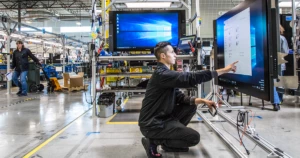Call Center Virtualization – 5 Critical Guidelines Insurance Execs May Miss
Many insurers are realizing a need for transitioning their call centers to operate under remote work models. The technological challenges associated with this type of undertaking are compounded by the need to drive those workloads under compressed timelines. Fortunately, this evolution can be managed quickly and with the equivalent security, agent experience, and customer experience as a traditional call center model.
Virtual Call Center Models vs. Remote Access
Two options exist in transitioning to a work-from-home (WFH) call center. Remote access, where employees use personal or company devices to interact with existing call center infrastructure; and virtualization which instead projects the call center environment to a remote location
Virtualization is the preferred approach for several reasons:
- Scalability
- Improved agent experience due to enhancements associated with virtualization
- Increased reliability
Guidelines
When evolving to a virtual call center model, insurers should seek to:
- Minimize customer service disruption and potential decline in CSAT scores
- Maintain consistent levels of service post-transition
- Create an equivalent work experience for call center agents as it relates to equipment, resources, disability accommodations, and internal support
- To help offset sales declines in an economic downturn, consider transitioning call center agents from being purely reactive / resolution driven, to providing proactive sales engagement. Tools such as AI insights, AI-based chatbot assistance, next-best action, and cross-sell / up-sell guidance can significantly enhance and accelerate these efforts.
- Adopt self-service options including customer web portals and mobile apps, augmented with AI-based chatbots. These options can provide effective resolution to many service-related requests and significantly reduce customer call volume.
Maintaining the Call Center Agent Experience
A virtual model eliminates the direct personal support normally available for call center agents. Additional challenges also arise around managing training and onboarding processes. Finally, insurers need to provide support for employees that previously relied on accessibility features and tools to accommodate disabilities.
One of the keys to addressing these issues lies in adopting a modern collaboration suite with native accessibility features. Such a platform provides real-time chat, video conferencing capabilities, and secure filesharing features which help provide the support experience agents typically receive in a call center environment.
Support and training requirements may also be enhanced through the integration of AI-based chatbots, providing knowledgebase access, onboarding & HR guidance, and policy query capabilities.
Components of a Virtual Call Center Model
A virtual call center model involves the adoption of specific technologies and devices:
IT infrastructure, software and telephony systems
- Cloud Telephony provider
- Cloud-based Agent Desktop
- Cloud-based CRM
- Workspace virtualization
- Modern collaboration suite
- AI-based chatbots (customer and agent-facing)
- Expanded self-service options (web portal, mobile app, etc.)
- Native accessibility features to accommodate a range of disabilities
- Embedded security
- Adequate internet bandwidth at individual employee worksites
- AI-based customer and agent-facing chatbots
Comprehensive equipment suite for workers
- Modern Workstations (computers, headsets, etc.)
- Accessibility accommodations as needed
A Roadmap for Planning & Managing Implementation
Microsoft’s approach for aiding insurers in the transition to a virtual call center model encompasses these steps:
- Microsoft account team will facilitate an Envisioning Session. The goal here is to assess current business needs, and evaluate what the potential impact of virtualization will have on customers, agents, and the business
- Analyze current call center configuration
- Microsoft will work with you to develop a roadmap for virtualization, and engage a specialized systems integrator to facilitate rapid deployment
- Acquire appropriate Azure cloud services
- Acquire required software licensing
- Acquire agent devices / equipment to support home-based model (may augment with Microsoft Virtual Desktop for personal devices)
- Microsoft technical specialists and systems integrators will coordinate on implementation
Microsoft and our Insurance Industry Account Teams are positioned to help insurers manage the full transformation of their call centers to a virtual model quickly, effectively, and securely. To schedule a discussion, please reach out to your Microsoft representative or complete the short request form here https://dynamics.microsoft.com/en-us/contact-us/ and a Microsoft representative will contact you.




